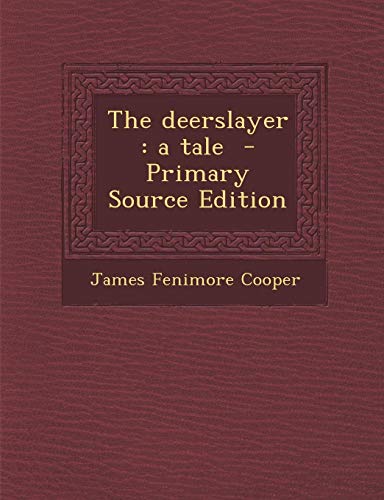Items related to The Deerslayer: A Tale - Primary Source Edition

"synopsis" may belong to another edition of this title.
James Fenimore Cooper’s literary reputation has undergone striking vicissitudes over the years. Hailed in his lifetime (1789 1851) as America’s first great novelist and lionized throughout the Western world, he fell into the literary doldrums at the end of the nineteenth century (in his own country at least) and languished there for many years. So complete was his fall that he became almost an object of ridicule among critics and literary commissioners. Later generations found it hard to imagine that he had once been an icon in the American literary canon. More recently, however, there has been a revival of interest in Cooper and a reconsideration of his literary reputation.
His death in Cooperstown on September 14, 1851, and a memorial service held the next month in New York City brought tributes from Daniel Webster, Ralph Waldo Emerson, Nathaniel Hawthorne, Herman Melville, Washington Irving, Henry Longfellow, William Cullen Bryant, and other leading American men of letters. In Europe, Thackeray, Balzac, Goethe, Scott, Lafayette, Carlyle, Sand, and Sue were among the many admirers of Cooper’s writings. So were, later, Joseph Conrad, who paid tribute in particular to Cooper’s seafaring works, and D. H. Lawrence, who was so inspired by Cooper’s treatment of the frontier that he came to spend several years living in the American West. Cooper was probably even more popular in Europe than he was in his own country, and he earned much of the money he made as America’s first successful professional writer from overseas sales of his works.
A controversialist, Cooper provoked unease from his countrymen as well as veneration. His popularity waned after his return to America in 1833 from a seven-year absence spent traveling in Europe; upon his return, he criticized the materialism and crassness he saw in America that had changed for the worse. He was not afraid to join in political fights and to hit back at enemies he became something of a public scold in his later years, and he emulated his father’s recourse to the courts to redress wrongs. He stirred the ire of Whig newspaper publishers who had always distrusted him and disliked, in particular, his novels Homeward Bound (1838) and Home as Found (1838). He was variously assailed at different times for being too Jacksonian and hostile to authority, and for being too aristocratic and class conscious. It is doubtful, however, whether Cooper really felt comfortable with any political party, and his political ideas certainly did not add up to a coherent political philosophy. He was nominally a Jackson Democrat but had a strong distrust of populist sentiments and of demagogues who stirred up the uneducated masses. Although a charming and gregarious man in his youth, Cooper came to be almost a recluse in later years and at times displayed a gift for making enemies. Many of the attacks on Cooper, though, were libelous, for he won the suits he instituted.
Cooper was wedded to his upstate New York region but was also a cosmopolitan who traveled widely; he was a romantic spinner of tales but also a realist who closely observed social mores, manners, and class status even in his novels set in the wilderness. Cooper was an optimist but one with a paranoid streak and a dark side. He lived mostly in the company of women but wrote mostly about men, male friendships, and heroes who broke free of or who never knew the bonds of domesticity. Cooper was as hard a man to understand for his contemporaries as he is for us now. Was he a reactionary or a man ahead of his times, an apologist for white America or a champion of Native Americans? Did he affirm the conquest of the wilderness or was he an early ecologist? As Robert Emmet Long comments, Two centuries after his birth, he remains an American enigma” (James Fenimore Cooper, p. 13; see For Further Reading”).
Yet for all of the controversy his life stirred, Cooper’s literary reputation remained largely intact until the end of the nineteenth century. He was, indeed, a cultural icon in a broad sense. His fiction redefined the past for the country, invented the idea of the Western frontier, and gave Americans a mythic sense of themselves and their destiny. He was a patron of the visual arts. Cooper’s writings stimulated interest in American history and fostered the professional writing of history, even though his novels often subordinated historical reality to archetype and myth. His interest in the Navy was genuine and was grounded in firsthand experience, and he was familiar with many of the personages he wrote about in The History of the Navy of the United States of America (1839), which was a classic study of its kind. Cooper’s friend George Bancroft, the distinguished Harvard historian, interpreted the American Revolution in terms similar to the story lines and subtexts of Cooper’s novels dealing with the revolution, and he patterned his style of narrative history writing after Cooper’s narrative techniques. Moreover, Cooper did much to fashion and to expand the popular audience for his novels (and for the writers who followed him). His works were issued and reissued after his death.
"About this title" may belong to another edition of this title.
- PublisherNabu Press
- Publication date2013
- ISBN 10 128987199X
- ISBN 13 9781289871994
- BindingPaperback
- Number of pages536
- Rating
(No Available Copies)
Search Books: Create a WantIf you know the book but cannot find it on AbeBooks, we can automatically search for it on your behalf as new inventory is added. If it is added to AbeBooks by one of our member booksellers, we will notify you!
Create a Want
